Hocus pocus title aside, “Big Magic” serves up delightfully grounded advice on mustering up the courage and sanity to live creatively. That is, by Gilbert’s definition, to live a life informed by curiosity, not fear or shame.
The occult does make an appearance in the book, but it’s largely confined to one section in which Gilbert sets forth some quirky beliefs about creativity and its “not entirely human” origins. She sees ideas as sentient, energetic life forms that “magically collaborate” with human partners, who escort them “out of the ether and into the realm of the actual.”
But beneath this New Age-y veneer, the book is supremely pragmatic. Gilbert conjures images of the surreal and otherworldly, not to exalt creativity, but to take the pressure off humans trying to enact it. She mentions the supernatural in order to inspire humble, joyful collaboration with the sources of inspiration.
“Just because creativity is mystical doesn’t mean it shouldn’t also be demystified–especially if it means liberating artists from the confines of their own grandiosity, panic, and ego,” she writes.
And we’re all artists in this account, not just the painters or writers among us. Gilbert insists that we each have the capacity to amplify our existences through the fine art of ”continually and stubbornly bringing forth the jewels that are hidden within [us].” This notion of a heightened existence is compelling. For some readers “Big Magic” will be a reminder that there’s more to life than the mundane. For others it will be a field guide for pursuing transcendent moments.
At heart, the book is an extended, and persuasive, account of the powers of curiosity, bravery, and persistence. Gilbert gives us the example of Susan, a friend who takes up figure skating after a 25-year hiatus because she is curious to see if she still loves it. Turns out she does, and she starts skating three mornings a week. Susan feels alive and ageless cutting across the ice, like she’s more than the sum of daily obligations and duties. “She was making something of herself, making something with herself,” Gilbert writes.
Beyond nudging us to try new things, curiosity also helps tamp down sabotaging emotion, in Gilbert’s reckoning. “Sometimes I think that the difference between a tormented creative life and a tranquil creative life is nothing more than the difference between the word awful and the word interesting,” she writes. “Interesting outcomes, after all, are just awful outcomes with the volume of drama turned way down.”
This is a sharp insight, elegantly rendered. And the prominence Gilbert gives to curiosity as both inspiration and palliative contrasts sharply with more tortured literary voices. In specific, Gilbert calls out Norman Mailer’s claim that each book “killed him a little more” and Oscar Wilde’s description of the artistic life as “one long, lovely suicide” as dramatic (and detrimental) examples.
Gilbert skewers the Tormented Artist stereotype again and again. The repetition is convincing and may save some readers from fruitless crusades into the darkness of dissatisfaction and self-pity when courage, trust and constancy would yield better results. “Since when did creativity become a suffering contest?” she asks. “[T]o suggest that nobody ever made valuable art unless they were in active emotional distress is not only untrue, it’s also kind of sick.”
Her own instincts, she shares, drove her “in the opposite direction–toward light, toward play, toward a more trusting engagement with creativity.” And with great results. This is the author of “Eat Pray Love” and “The Signature of All Things” we’re talking about, after all. Her track record lends great credibility to her promotion of a lighter, more joyful approach to creativity. Not only because her books are commercial successes, but because she was personally, positively transformed by writing them.
“Your creative work is not your baby; if anything, you are its baby,” she writes. “Everything I have ever written has brought me into being. Every project has matured me in a different way. I am who I am today precisely because of what I have made and what it has made me into.”
You creative work is not your paycheck, either, Gilbert also reminds us. (Not at first, anyway.) “Big Magic” doesn’t condone Big Delusions.
Thinking about quitting your day job? Gilbert discourages it. When embarking upon her own writing journey she vowed that she “would never ask writing to take care of [her] financially, but that [she] would always take care of it.”
Weighing the pros and cons of getting an MFA? Gilbert says to check your bank account balance for the answer. “If you’re considering some sort of advanced schooling in the arts and you’re not rolling cash, I’m telling–you can live without it. You can certainly live without the debt, because debt will always be the abattoir of creative dreams.”
In the final assessment, Gilbert’s Big Magic sounds a lot like good sense and daily toil–and it’s a credit to her creativity that she presented that age-old wisdom in a warm, fresh package.
If this review resonates with you, I bet you’ll enjoy my newsletter. I regularly send bookish news and notes out to more than 1,000 readers. Sign up here.


